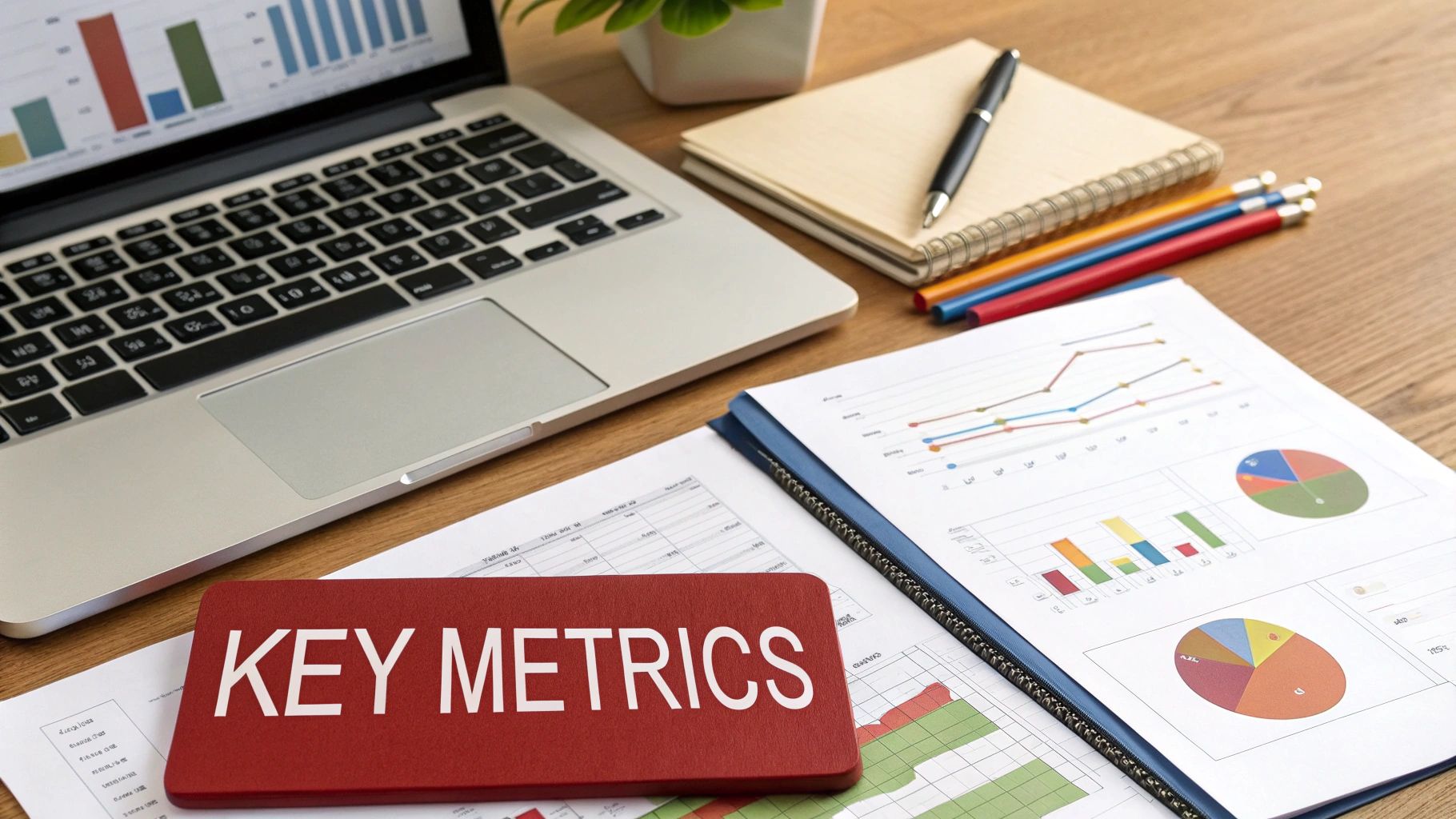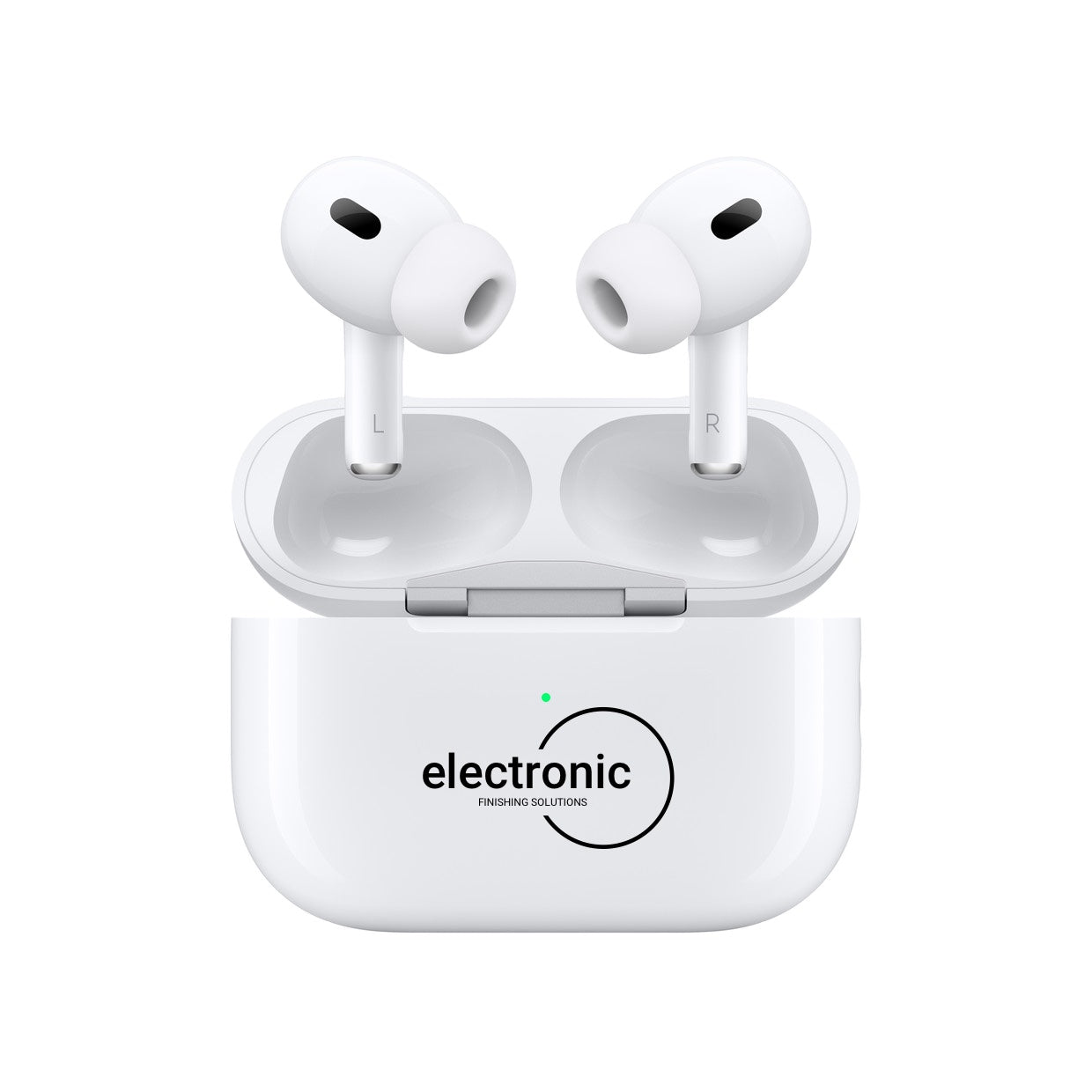Why Measuring Brand Awareness Matters Beyond Basic Recognition

Measuring brand awareness is more than just a checkbox on a marketing plan. It's a critical component of understanding your position in the market and a key driver of business growth. It's all about grasping how your target audience perceives your brand and how that perception influences their buying decisions. Ultimately, this understanding can have a significant impact on your profits.
For example, brands with high awareness often benefit from lower customer acquisition costs. This is because familiar brands require less marketing spend to convert prospects into paying customers.
Strong brand awareness also provides a competitive advantage. In today's competitive marketplace, consumers face a constant barrage of options. A recognizable brand cuts through the noise, offering a sense of familiarity and trust that can heavily influence purchasing decisions. Measuring brand awareness offers valuable data to make strategic investments, allowing businesses to allocate resources wisely and maximize their return on investment (ROI). You might be interested in: Our blog sitemap for more information on related topics.
The Impact of Brand Awareness on Consumer Behavior
Consumer purchasing behavior offers significant global insights into the power of brand awareness. Studies show that 15% of new product purchases worldwide are attributed to well-known or popular brands. This indicates that brand recognition plays a significant role in consumer choices.
Moreover, 59% of global shoppers prefer buying new products from brands they already know. Another 21% of new product purchases come from brands consumers already support. Find more detailed statistics here: Branding Statistics. This data clearly highlights the impact of brand familiarity on sales and underscores the importance of investing in brand-building activities.
Demonstrating the ROI of Brand Awareness
Measuring brand awareness enables you to demonstrate the ROI of your marketing spend. By tracking important metrics, you can clearly show how increased awareness translates into tangible business results. This data-driven approach allows you to justify budget allocations for brand-building initiatives and secure buy-in from key stakeholders.
Building a Strong Brand for Long-Term Success
Ultimately, measuring brand awareness contributes to building a stronger, more resilient brand. By understanding audience perception and tracking progress, you can refine your messaging, target your marketing more effectively, and build long-term customer loyalty. This fosters sustainable growth and strengthens your brand's market position, creating a positive feedback loop where increased awareness leads to stronger brand equity, further enhancing awareness.
Essential Metrics That Actually Track Brand Awareness Progress
Measuring brand awareness involves more than just name recognition. It's about understanding how your brand resonates with consumers. To gain this understanding, businesses track quantitative and qualitative metrics, providing a holistic view of brand positioning. These metrics offer crucial insights into consumer perception and inform strategic decisions.
Quantitative Metrics: Measuring the Numbers
Quantitative metrics offer concrete data on your brand's reach and influence. Brand Recall Rate is a key metric, measuring the percentage of consumers who can name your brand unaided within a specific product category. For example, if 700 out of 1,000 surveyed consumers mention your brand without prompting, your brand recall rate is 70%. This, combined with other quantitative data, clearly illustrates brand recognition. For a deeper dive into understanding global brand performance, check out this resource on global brand performance metrics.
- Website Traffic: Analyzing direct website traffic, especially branded searches, reveals active consumer interest.
- Social Media Engagement: Metrics like mentions, shares, and follower growth reflect online brand discussion frequency.
- Sales Data: While not a direct awareness measure, increased sales, especially for new products, can indicate growing recognition.
- Market Share: This metric indicates your brand's market portion compared to competitors, reflecting overall brand strength and awareness.
Qualitative Metrics: Understanding Consumer Perceptions
Qualitative metrics provide a deeper understanding of how consumers perceive your brand, going beyond simple recognition. These metrics often involve gathering direct feedback.
- Brand Sentiment: Analyzing online conversation tone and context helps determine if perceptions are positive, negative, or neutral.
- Customer Surveys: Surveys directly collect consumer opinions and their associations with your brand.
- Focus Groups: In-depth discussions with small consumer groups reveal detailed brand perceptions and associations.
- Social Listening: Monitoring online conversations and forums provides valuable, unfiltered feedback on brand perception, offering a natural view of consumer opinions.
To better illustrate the differences and similarities between these crucial metrics, let's take a look at the table below. This table provides a comparison of various brand awareness metrics, focusing on their measurement difficulty, cost, and the value of the insights they provide.
Essential Brand Awareness Metrics Comparison
| Metric | What It Measures | Collection Method | Cost Level | Implementation Difficulty | Insight Value |
|---|---|---|---|---|---|
| Brand Recall Rate | Percentage of consumers who can name your brand unaided | Surveys, Focus Groups | Moderate | Moderate | High |
| Website Traffic | Number of visitors to your website | Website analytics (Google Analytics) | Low | Low | Medium |
| Social Media Engagement | Likes, shares, comments, and mentions on social media platforms | Social media analytics tools (SproutSocial) | Low to Moderate | Low to Moderate | Medium |
| Sales Data | Number of products or services sold | Sales tracking software | Low | Low | Low (Indirect measure) |
| Market Share | Percentage of the total market held by your brand | Industry reports, Market research | Moderate to High | High | High |
| Brand Sentiment | Positive, negative, or neutral feelings towards your brand | Social listening, Sentiment analysis tools | Moderate | Moderate | High |
| Customer Surveys | Direct feedback from customers about your brand | Survey platforms (SurveyMonkey) | Low to Moderate | Low to Moderate | High |
| Focus Groups | In-depth qualitative feedback from a small group of consumers | Moderated discussions | Moderate to High | High | High |
| Social Listening | Unfiltered conversations and mentions of your brand online | Social listening tools (Brand24) | Moderate | Moderate | High |
This table summarizes how different metrics contribute to understanding brand awareness, each offering unique insights. Choosing the right combination depends on your specific business goals and resources.
Combining Metrics for a Holistic View
Effective brand awareness measurement uses both quantitative and qualitative metrics. Each offers a unique perspective, and together they create a complete picture. For instance, high website traffic and positive brand sentiment indicate strong awareness and positive perception. Conversely, high recall with negative sentiment reveals underlying brand issues that need addressing. This multifaceted approach reveals not only how many recognize your brand but also what they think about it. Explore our product sitemap for products that enhance brand visibility.
This holistic approach reveals your audience's true understanding and perception of your brand. Combining the "what" and the "why" behind consumer perception leads to informed decisions that drive brand growth and success.
Tech Stack Secrets: Tools That Transform Brand Measurement

Accurately measuring brand awareness requires a strategic approach. It demands a powerful toolkit capable of capturing and analyzing data from various sources. This exploration delves into the technology ecosystem that empowers precise brand tracking and measurement.
Social Listening: Capturing the Online Buzz
Social listening tools offer valuable insights into online brand mentions and conversations. These tools track mentions across platforms, analyze sentiment, and identify key influencers discussing your brand. This provides a real-time understanding of public perception. It helps you understand how your brand resonates organically.
- Brand24: This tool delivers real-time alerts for brand mentions, allowing you to monitor conversations and engage directly with your audience.
- Mention: Similar to Brand24, Mention tracks mentions across multiple platforms and offers detailed sentiment analysis. This helps you understand the tone and context surrounding online discussions about your brand.
- SproutSocial: This platform combines social listening with social media management capabilities. It enables monitoring conversations and responding efficiently.
Survey Platforms: Gathering Direct Consumer Feedback
Survey platforms empower you to gather direct insights from your target audience. These tools allow you to create custom surveys, distribute them to specific demographics, and analyze responses. This data is crucial for measuring brand recall and understanding consumer associations with your brand.
- SurveyMonkey: This popular platform provides a user-friendly interface for creating and distributing surveys, making it accessible for everyone.
- Qualtrics: This enterprise-grade platform offers advanced survey features. This includes sophisticated branching logic and powerful reporting capabilities.
- Typeform: Known for its visually engaging surveys, Typeform encourages higher response rates through interactive elements.
Website Analytics: Measuring Digital Footprints
Website analytics tools track visitor behavior on your website. They provide data on direct traffic, referral sources, and popular content. This data reveals which marketing efforts are driving awareness and how consumers interact with your brand online.
- Google Analytics: This free tool from Google provides comprehensive website traffic data, including demographics, user behavior, and conversion rates.
- Adobe Analytics: This enterprise-level platform provides advanced analytics features, including real-time data analysis and predictive capabilities.
Combining Tools for a Holistic View
Effectively measuring brand awareness often involves combining data from various tools. Using social listening data with website analytics, for instance, provides a broader understanding of online brand visibility and engagement. These combined insights create a comprehensive picture of your brand's presence.
Choosing the Right Tools: Budget and Objectives
Choosing the right tools depends on your budget and objectives. Some platforms offer free basic plans, while others provide premium features at a cost. Understanding your specific needs is essential for making informed decisions about technology investments. A targeted approach ensures you're investing in tools that align with your goals.
Survey Techniques That Deliver Reliable Brand Awareness Data
Gathering meaningful insights about brand awareness involves more than just asking simple questions. It requires thoughtful survey design to minimize bias and maximize both the quantity and quality of responses. Let's explore how successful brands accomplish this.
Structuring Questions for Aided and Unaided Recall
A crucial aspect of measuring brand awareness involves understanding the difference between aided and unaided recall. Aided recall gives respondents clues, such as a list of brands, and asks them which ones they recognize. This helps measure familiarity within the competitive landscape.
Unaided recall, on the other hand, asks respondents to list brands within a category without any hints. This measures top-of-mind awareness, indicating a stronger brand presence. Structuring questions effectively for both recall types is essential for collecting precise data.
For example, an aided recall question might be, "Which of the following electronics brands are you familiar with?" An unaided recall question could be, "Name three electronics brands that come to mind."
Sampling and Distribution Methods
Reaching the right respondents is fundamental for accurate brand awareness measurement. Sampling techniques help ensure the surveyed group represents your target market. This might involve stratified sampling based on demographics or location.
Distribution methods, equally important, determine how the survey reaches potential participants. Online surveys through email or social media platforms like Facebook offer broad reach, while phone surveys can focus on specific demographic groups. The chosen method directly affects data reliability and relevance.
Avoiding Common Survey Pitfalls
Several common mistakes can skew survey results and compromise data reliability. Leading questions can subtly influence answers, while ambiguous wording can cause confusion. Survey length also matters, with longer surveys often resulting in lower completion rates.
Recognizing and avoiding these pitfalls is crucial for acquiring clean, reliable data. Instead of asking, "Do you prefer our superior brand?", a more neutral question would be, "Which electronics brand do you prefer?"
Interpreting Survey Findings and Taking Action
Collecting data is just the first step. The true value lies in interpreting findings and turning them into actionable insights. This involves analyzing response patterns, pinpointing trends, and forming conclusions about your brand's market position.
These insights can guide decisions related to brand positioning, messaging, and marketing initiatives. Measuring brand awareness is not merely a research exercise; it's a vital step towards driving business growth.
For example, low unaided recall could indicate a need for campaigns to increase brand visibility. High aided recall combined with low unaided recall might suggest focusing on strengthening brand differentiation and top-of-mind awareness.
Leveraging Digital Channels to Measure Brand Visibility

Digital channels provide a wealth of data about your brand's online presence. Analyzing these digital signals offers key insights into how consumers perceive and interact with your brand. This understanding is essential for accurately measuring brand awareness and developing effective marketing strategies.
Tracking Direct Brand Searches
One of the most straightforward ways to gauge brand awareness is by tracking direct brand searches. This metric measures how often people specifically search for your brand name on search engines like Google. A high volume of these searches suggests strong brand recognition and proactive consumer interest.
For example, frequent searches for "Electronic Finishing Solutions custom AirPods" indicate active consumer intent and strong brand recall. This data provides valuable insight into which products consumers are seeking and how familiar they are with your brand.
Analyzing Sentiment of Online Mentions
Beyond simply counting mentions, understanding the sentiment behind them is crucial. Sentiment analysis, often facilitated by specialized tools, categorizes online mentions as positive, negative, or neutral. This provides a deeper understanding of public perception.
Positive sentiment reinforces a healthy brand image. Negative feedback highlights areas requiring attention and improvement. This analysis helps paint a more comprehensive picture of consumer perception.
Monitoring Visual Brand Recognition
In today's visually-driven world, monitoring visual brand recognition is paramount. This involves tracking how often your brand’s logo, colors, or other visual elements are shared and recognized online. This reveals the effectiveness of your visual identity and how well it differentiates you from competitors.
Consistent visual presence strengthens brand identity and improves memorability. It ensures your brand remains top-of-mind for consumers.
Integrating Digital and Traditional Metrics
A comprehensive understanding of brand visibility requires integrating digital indicators with traditional awareness metrics. This holistic approach provides a more complete picture of your brand's overall reach and impact.
To better illustrate this integration, let's examine some key metrics across various digital channels:
Digital Channel Brand Awareness Metrics: Key metrics for measuring brand awareness across different digital platforms.
| Digital Channel | Primary Metrics | Secondary Metrics | Data Collection Method | Insight Value |
|---|---|---|---|---|
| Search Engines | Direct Brand Searches, Search Volume for Related Keywords | Click-Through Rate, Search Engine Rankings | Google Search Console, SEO Tools | High |
| Social Media | Mentions, Shares, Comments, Follower Growth | Sentiment Analysis, Reach, Engagement Rate | Social Listening Tools, Platform Analytics | High |
| Websites | Direct Traffic, Referral Sources, Time on Site | Bounce Rate, Conversion Rate | Website Analytics | Medium |
| Forums and Review Sites | Mentions, Reviews, Ratings | Sentiment Analysis, Topic Trends | Social Listening Tools, Web Scraping | Medium |
This table summarizes key metrics for measuring online brand awareness across different digital channels. It offers a structured approach to gathering and interpreting data.
You might be interested in: Our sitemap for a broader view of our resources. Combining digital insights with traditional methods like surveys and focus groups provides a powerful, multifaceted understanding of brand awareness. This approach enables more informed decisions regarding marketing strategies and brand-building initiatives. It helps ensure your efforts effectively reach your target audience both online and offline.
Creating Benchmarks That Show Real Brand Awareness Progress
Isolated metrics don't tell the whole story. To truly grasp your brand awareness progress, you need benchmarks. These points of comparison reveal meaningful shifts over time and inform smarter strategies. Let's explore how top brands establish effective benchmarks to demonstrate real growth.
Establishing Internal Historical Benchmarks
Tracking historical performance provides a crucial baseline. Consistently gathering data on key metrics like brand recall and website traffic at regular intervals paints a clear picture of your brand's trajectory.
For example, if your brand recall increased from 30% last year to 40% this year, that's quantifiable improvement. This internal data reveals the effectiveness of your marketing campaigns and pinpoints areas for growth. Consistent tracking forms the foundation of a strong internal benchmark for future success.
Leveraging Competitive Intelligence for External Comparison
Internal benchmarks offer valuable context, but external comparisons add another layer of insight. Competitive intelligence, the process of gathering data on your competitors, illuminates their brand awareness levels. This lets you assess your brand's performance within the broader market.
Understanding your competitors' strengths and weaknesses reveals opportunities. You can differentiate your brand and gain a competitive edge. This external benchmarking offers crucial market context, highlighting areas where your brand excels and areas needing improvement.
Setting Realistic Goals Based on Industry and Resources
Benchmark setting demands realism. Consider your industry, available resources, and current market position. Unrealistic goals can be demotivating, while overly modest goals may not drive significant improvement.
A new brand in a competitive market shouldn’t expect to match established competitors overnight. Focus on incremental growth, steadily building recognition over time. This measured approach sets realistic expectations and allows for sustainable progress.
Measuring Progress Through Campaign Spikes and Normal Periods
Brand awareness naturally fluctuates. Marketing campaigns create temporary spikes, while normal periods reveal a more consistent baseline. Measuring progress in both scenarios is essential.
Tracking campaign spikes isolates short-term impact. Monitoring awareness during normal periods shows sustained recognition. Analyzing both provides a balanced understanding of your brand's overall awareness trajectory.
Building Sustainable Measurement Systems
Sustainable measurement requires consistency. Regularly collect data on the same metrics, using the same tools and techniques. This ensures reliable data and enables accurate comparison over time.
A structured approach to data collection builds a strong framework for evaluation. It empowers you to make data-driven decisions and adjust your strategies accordingly.
Transforming Market Position Through Systematic Measurement
Systematic measurement is a powerful tool for transforming market position. By tracking progress over time, you uncover actionable insights: what's working, what's not, and where to focus your efforts. This allows for strategic interventions that genuinely boost awareness.
For instance, if your data shows low brand recall in a key demographic, implement targeted campaigns to increase visibility and recognition within that segment. Data-driven decisions like these are critical for improving brand awareness and achieving sustained growth.
Connecting Brand Awareness Metrics to Business Outcomes

Measuring brand awareness is essential. But its true value lies in connecting it to tangible business results. Does increased awareness translate into a stronger bottom line? This section explores linking awareness metrics to the outcomes that matter most to executives.
Correlating Awareness with Customer Acquisition Costs
Successful brands understand the crucial relationship between brand awareness and customer acquisition cost (CAC). High awareness often leads to a lower CAC.
When consumers are already familiar with your brand, less marketing is needed to persuade them to buy. This means brand building can significantly impact marketing budget efficiency. For example, a well-known brand might convert leads with minimal advertising. A lesser-known brand might require extensive campaigns and higher ad spend for the same conversions. This direct correlation highlights the importance of measuring brand awareness alongside CAC.
The Link Between Awareness and Conversion Rates
Brand awareness significantly influences conversion rates. Familiar brands build trust and confidence, making consumers more likely to purchase. This is particularly important in competitive markets where consumers face countless choices.
A recognizable brand can be the deciding factor, swaying a customer toward a familiar name over an unknown competitor. Tracking conversion rates alongside awareness metrics demonstrates how increased recognition improves sales performance.
Brand Awareness and Customer Lifetime Value
The impact of brand awareness extends beyond initial purchases. It also affects customer lifetime value (CLTV). Customers familiar with your brand and its offerings are more likely to become loyal advocates and repeat buyers.
This long-term impact strengthens the argument for investing in brand building. Loyal customers generate repeat business and contribute to positive word-of-mouth marketing, further amplifying brand awareness efforts.
Attribution Modeling for Brand Awareness
Understanding brand awareness's contribution throughout the sales funnel requires effective attribution modeling. This involves assigning value to different touchpoints a customer interacts with before purchasing. While click-based attribution focuses on immediate conversions, it often overlooks the long-term effects of brand awareness campaigns.
Incorporating brand awareness metrics into your attribution model gives a more complete picture of marketing effectiveness. It accurately reflects brand building's influence on the entire customer journey. This means looking beyond immediate conversions and recognizing awareness's role in fostering long-term customer relationships. You might be interested in: Our sitemap for additional resources on website performance.
Demonstrating the Financial Impact of Awareness
Building financial models that directly link awareness to revenue growth is critical. This shifts the perception of brand building from a marketing expense to a business asset. It involves quantifying the impact of increased awareness on metrics like CAC, conversion rates, and CLTV.
By showcasing these financial benefits, marketers can advocate for brand-building resources and demonstrate the ROI of their efforts. This underscores the importance of brand awareness as a driver of business growth and long-term value.
Real-World Examples and Advocacy for Resources
Real-world examples of how companies have successfully connected awareness to revenue growth are powerful advocacy tools. Showcasing how increased awareness has led to tangible business outcomes in similar organizations helps build a compelling case for investing in brand-building initiatives. This data-driven approach reinforces that brand awareness is a key driver of business success.
Ready to elevate your brand with high-quality, custom-branded electronics? Visit Electronic Finishing Solutions to explore how we can help.



